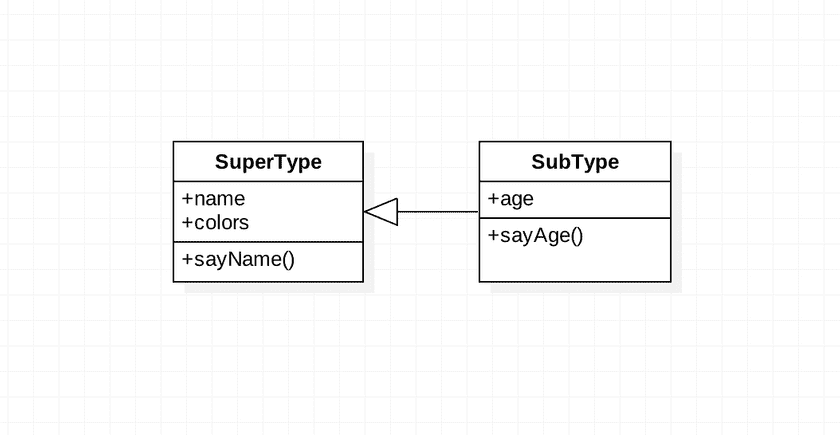这篇文章总结 class 相关,并辐射出周边需要了解的知识点,便于形成巩固自己的心理表征。
如何编写一个类?
在 ES6 还没出来之前,前端在编写 class 时,相比去其他设计成熟的语言会显得很诡异,比如使用 JS 原生的方式实现一个类继承,这个我在之前的文章中有说明。
下面是 UML 说明:

传统的基于原型的实现:
// 1. 父类定义
function SuperType(name) {
this.name = name;
this.colors = ["red", "blue", "green"];
}
SuperType.prototype.sayName = function() {
console.log(this.name);
};
// 2. 子类定义
function SubType(name, age) {
// 2.1 继承了 SuperType 构造函数中定义的属性
SuperType.call(this, name);
// 2.2 子类自己的属性
this.age = age;
}
// 父类原型链复制
SubType.prototype = Object.create(SuperType.prototype);
// 因为使用“.prototype =...”后,constructor会改变为“=...”的那个
// constructor,所以要重新指定.constructor 为自身。
SubType.prototype.constructor = SubType;
SubType.prototype.sayAge = function() {
console.log(this.age);
};
// 3. 实例化
var instance1 = new SubType("name1", 12);
instance1.colors.push("black");
instance1.sayName(); // name1
console.log(instance1.colors); //"red,blue,green,black"
var instance2 = new SubType("name2", 33);
instance2.sayName(); // name2
console.log(instance2.colors); //"red,blue,green"ES6 出来之后,关于 class 的实现就和其他高级语言差不多了,但是也仅仅是阉割版。ES6 实现如下:
// 1. 父类定义
class SuperType {
constructor(name) {
this.name = name;
this.colors = ["red", "blue", "green"];
}
sayName() {
console.log(this.name);
}
}
// 2. 子类定义
class SubType extends SuperType {
constructor(name, age) {
// 2.1 继承了 SuperType 构造函数中定义的属性
super(name);
// 2.2 子类自己的属性
this.age = age;
}
sayAge() {
console.log(this.age);
}
}
// 3. 实例化
var instance1 = new SubType("name1", 12);
instance1.colors.push("black");
instance1.sayName(); // name1
console.log(instance1.colors); //"red,blue,green,black"
var instance2 = new SubType("name2", 33);
instance2.sayName(); // name2
console.log(instance2.colors); //"red,blue,green"TypeScript 加强了 class 的实现,这也是我比较看好 TypeScript 的原因,可以渐进的从弱类型(指定 any)一直到强类型(指定类型)过渡。下面是 TypeScript 实现相同功能的代码,从代码中可以看出,其实代码没变化多少:
// 1. 父类定义
class SuperType {
constructor(name: string) {
this.name = name;
this.colors = ["red", "blue", "green"];
}
sayName() {
console.log(this.name);
}
}
// 2. 子类定义
class SubType extends SuperType {
constructor(name: string, age: number) {
// 2.1 继承了 SuperType 构造函数中定义的属性
super(name);
// 2.2 子类自己的属性
this.age = age;
}
sayAge() {
console.log(this.age);
}
}
// 3. 实例化
var instance1 = new SubType("name1", 12);
instance1.colors.push("black");
instance1.sayName(); // name1
console.log(instance1.colors); //"red,blue,green,black"
var instance2 = new SubType("name2", 33);
instance2.sayName(); // name2
console.log(instance2.colors); //"red,blue,green"通过以上的发展对比可以看出,前端的 JavaScript 基础设施正在被加强,且都有背后大厂的支持,未来能够继续保持比较快的发展趋势。这也是我为什么喜欢前端的原因。
ES6 中使用 class 的注意点有哪些?
- class 先定义再使用,不存在变量提升
- 不存在私有属性和方法
- 可以定义静态属性和方法,静态方法中的 this 指向 class 本身
class Foo {
static bar() {
this.baz(); // this === Foo
}
static baz() {
console.log("hello");
}
baz() {
console.log("world");
}
}
Foo.bar(); // hello- 实例属性可以不在
constructor中定义,直接写在外面
class ReactCounter extends React.Component {
state = {
count: 0
};
}new.target的使用技巧:感知当前类的继承情况
class Shape {
constructor() {
if (new.target === Shape) {
throw new Error("本类不能实例化");
}
}
}
class Rectangle extends Shape {
constructor(length, width) {
super();
// ...
}
}
var x = new Shape(); // 报错
var y = new Rectangle(3, 4); // 正确- 理解继承类中的
super函数(这部分有三种情况)
class Parent {
static myMethod(msg) {
console.log("static", msg);
}
myMethod(msg) {
console.log("instance", msg);
}
}
class Child extends Parent {
constructor(name) {
super(); // 1. super()===Parent.prototype.constructor.call(this)
this.name = name;
}
static myMethod(msg) {
super.myMethod(msg); // 2. super===Parent
}
myMethod(msg) {
super.myMethod(msg); // 3. super===Parent.prototype, 父类原型上的方法
}
}
Child.myMethod(1); // static 1
var child = new Child();
child.myMethod(2); // instance 2TypeScript 中使用 class 的注意点有哪些?
相关的注意点完全继承上面的关于 ES6 的内容,需要额外指明的如下:
- 支持 public、private、protected
- 支持 readonly 属性
- 其余参考文档
- 本文作者:烈风裘
- 本文题目:关于class
- 本文链接:https://xiangst0816.github.io/blog/guan-yu-class/
- 版权声明:本博客所有文章除特别声明外,均采用CC BY-NC-SA 3.0 许可协议。转载请注明出处!